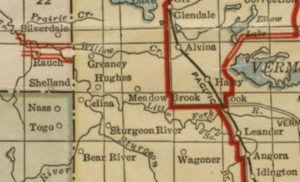Celina, Minnesota facts for kids
Quick facts for kids
Celina
|
|
|---|---|
| Country | United States |
| State | Minnesota |
| County | Saint Louis |
| Elevation | 1,319 ft (402 m) |
| Population | |
| • Total | 10 |
| Time zone | UTC-6 (Central (CST)) |
| • Summer (DST) | UTC-5 (CDT) |
| ZIP code |
55723
|
| Area code(s) | 218 |
| GNIS feature ID | 660973 |
Celina was a small, quiet community in Minnesota, in a place called Saint Louis County. It was an "unincorporated community," which means it didn't have its own local government like a city or town.
In the early 1900s, Celina was a busy little village. It had important places like a Lutheran church, a post office, and even general stores where people could buy everyday things. The community was located close to other small towns like Greaney and Bear River in Minnesota.
Where Was Celina Located?
Celina was about 18 miles west of a town called Cook. You could find it where two roads met: State Highway 1 (MN 1) and Saint Louis County Highway 5 (CR 5).
The community was also very close to where three different counties meet. These were Saint Louis County, Itasca County, and Koochiching County.
Celina was about 112 miles away from Duluth, Minnesota, which is the main city (county seat) for Saint Louis County. Other nearby communities included Greaney, Bear River, and Togo.
A Look at Celina's History
Celina was an active village in Saint Louis County during the early 1900s. It had a post office that helped people send and receive mail.
- The post office first opened in 1908.
- The first postmaster was Theodore Hall.
- It closed in 1913, and mail was sent through a place called Nass.
- The post office reopened in 1914 but closed again in 1935.
- Another person named John Gilbertson also worked as a postmaster there.
The Evangelical Lutheran Church was an important part of the community. The Celina Lutheran Church started in 1909. People in the area hoped to build a new church building. They also thought the area was a good place for more Norwegian Lutheran families to live.
Celina had two general stores where people could buy supplies. One of these stores was run by Theodore Hall, who was also the first postmaster.
In 1929, there were plans to build a lookout tower near Celina. This tower would help spot forest fires and protect the area.
In 1940, the population of Celina was very small, with only 5 people living there.
A bridge on the Little Fork River was badly damaged by fire in 1974. This bridge connected Celina with Greaney. It was 200 feet (about 61 meters) long. Repairing the bridge was very expensive. It was an important link between the two communities.
By 2006, the estimated population of Celina had grown a little to 10 people.




